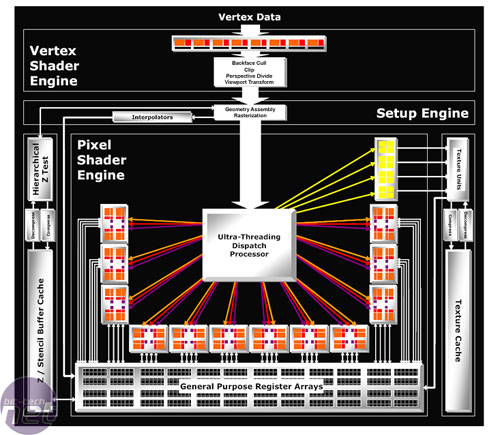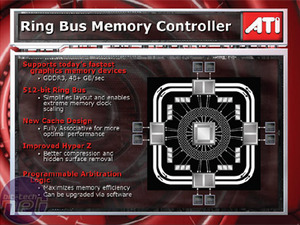Lets dive under the covers...
With product refreshes, one normally expects increased core frequencies or an increased number of pixel and vertex shader units. R580+ is different in that respect, because the only real improvement - aside from the all-new cooling solution - is the increased memory bandwidth, as a direct result of ATI opting for GDDR4 memory on its new flagship card.Not surprisingly, the GPU is a familiar sight - it's virtually the same R580 chip as the one under the Radeon X1900XTX heatsink, but there are some slight changes. ATI's much-discussed Ring Bus memory controller was built for the future, so GDDR4 support was included from the start. It is finally time to start seeing the fruits of the over-engineered behemoth.
If you're not familiar with ATI's Radeon X1000-series architecture, or the R580 architecture in particular, we recommend reading through the technological explanations that we outlined in our Radeon X1900-series and Radeon X1800-series coverage. The highlights of the architecture include support for HDR and anti-aliasing at the same time, High Quality anisotropic filtering, adaptive anti-aliasing, the Ring Bus memory controller and a focus on efficiency with ultra-threading.
In much the same the same way that we saw performance improvements in memory bandwidth limited scenarios on R520, it is quite possible that we will see more improvements over time with Radeon X1950-series. Because the Ring Bus memory controller is fully programmable, it is possible to enhance memory performance with simple memory remapping optimisations for certain types of data streams. ATI's Catalyst team has done this before - the release of Catalyst 5.11 improved the performance in OpenGL games like Quake 4, for example.
We think that it would be fair to say that Mr. Makedon and his Catalyst team have already started working on ways to further optimise performance in bandwidth limited scenarios with the new lease of life given to the Ring Bus memory controller. As always, we're skeptical when companies suggest massive performance improvements are possible with a new 'wonder' driver.
However, it will be interesting to see whether future Catalyst drivers with additional GDDR4 enhancements will deliver true real-world benefits to gamers in the form of improved playable image quality settings. If R520 is anything to go by, we can expect some performance enhancements in WHQL drivers in a couple of months time.

MSI MPG Velox 100R Chassis Review
October 14 2021 | 15:04














Want to comment? Please log in.